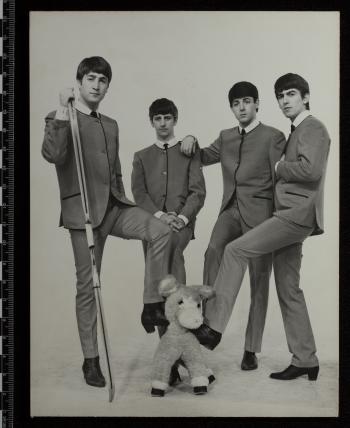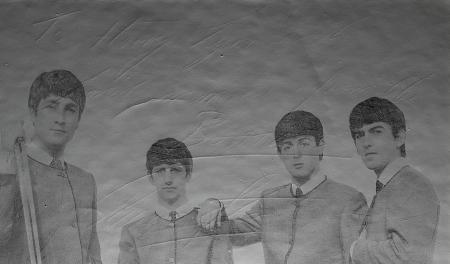As people versed in Integrated Pest Management, we're used to urgent emails that start, "can anyone identify this beetle invading my collection?" Recently, I received an inquiry regarding a very different species of invader. In February, everyone was talkin' 'bout the 50th anniversary of The Beatles' Invasion, or their arrival on the American shores to play the Ed Sullivan show (complete with its own hashtag #Beatles50). Beatlemania was alive again, especially in D.C., where the Fab Four had performed their first concert in the United States at the Washington Coliseum. Over at the Jewish Historical Society of Greater Washington, "on the eve of the 50th anniversary of the concert . . . archivists discovered a personal note on the back of a photo . . . written to [Harry Lynn, the owner of the Coliseum] and signed by the band." The only trouble was the archivists couldn't read it because the photograph was mounted to thick board – they could only see the impression of a couple of words, as you can see when Zachary Levine turns it in his hands as he shows it to the reporter in this news video (at about 1:23). So they contacted us to see if we could be of assistance, and sure enough I thought this would be a great way to test the limits of some techniques over at the Museum Conservation Institute's Imaging Studio.

I asked my colleague E. Keats Webb, if Reflectance Transformation Imaging (RTI), a technique that enhances dimension of surface features in low profile, could be used to augment the profile of signatures. Essentially, RTI uses multiple images of the same object photographed with raking light from multiple angles, and then with software, layers and interpolates them to create a moving image that can be adjusted to enhance the visible dimensionality.
As Keats moves the green virtual mouse ball to change the direction of the raking light, and changes surface interpolation filters, you can watch the writing below the boys' heads emerge. You can observe that the largest, but also deepest, signature is John Lennon's. His signature literally makes a strong impression – in a detail at high resolution in the Flickr set, you can see that the pressure he exerted created almost arrow-like cracks in the baryta layer below the silver. From this we can surmise that either he had a naturally heavy hand, or possibly he signed his name over a softer surface than all the others – allowing the pen to sink deeper.
Showing opposite characteristics, you can see relatively how much less deep George Harrison's autograph lies; he either wrote with a light hand, or on a hard surface. Another interesting feature is seen in in Paul McCartney's autograph. Can you guess what it is? Not being the biggest Beatles fan in the room, as the image became clearer to my eyes, I gasped and asked aloud, "Is Paul McCartney left-handed?" This is apparently a well-known fact to all those who are saturated with images of Sir Paul holding his bass guitar in the opposite direction to his bandmates. I guessed at it by observing the slant, direction and loops in which the 'P' and 'a' and other letters were started and continued across his name, and confirmed my speculation with a swift Wikipedia search. This observation is of an individual characteristic of Mr. McCartney's handwriting. Lastly, from the matching directional slant, and the center placement of Ringo Starr's autograph, the evidence suggests that Ringo wrote the full dedication: "To Harry Lynn | with fond memories from the | BEATLES", signed it himself and handed the photograph off for others' signatures, seen below.

We also used hyperspectral imaging but the silver and the baryta layer blocked the non-visible wavelengths of light from passing through the photographic print to the ink. However, ultraviolet induced fluorescence photography did reveal a history of adhesives. Also in the Flickr set, you'll see both the residues of a typical address label on the front at lower left corner, and on the back, traces of the damaging so-called "magnetic" adhesive that is common to some photo albums. In fact, the item had been stored in "the sticky embrace" of one, as colorfully described in this lovely article about the provenance of the photograph.
This was a really fun project, but also one which raised serious philosophical questions. Some may ask, but why didn't you just take the backing off to see the autographs? Well, excavation and solvents carry risk for both the object and the conservator. In modern archaeology, sites may be investigated with remote sensing equipment, uncovered, documented, and recovered to protect the integrity of the site. Do we really need to dig for what is definitely there when we have non-destructive ways of seeing? Seriousness aside, can anyone tell me what is going on in this image with the bow and the stuffed cow?
Related Resources
- Jewish Historical Society of Greater Washington
- Museum Conservation Institute, Smithsonian Institution
- Smithson's Draft Will: A Case for Handwriting, The Bigger Picture blog, Smithsonian Institution Archives
- Sticky Photo Albums, Smithsonian Institution Archives
Produced by the Smithsonian Institution Archives. For copyright questions, please see the Terms of Use.

Leave a Comment